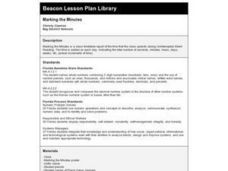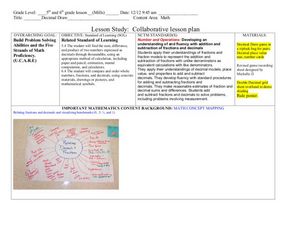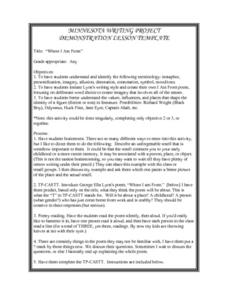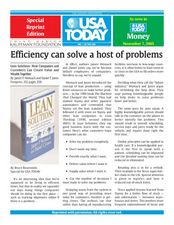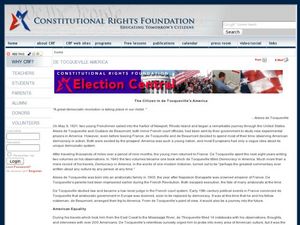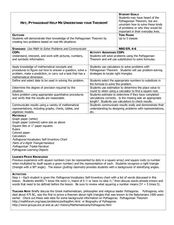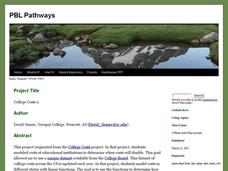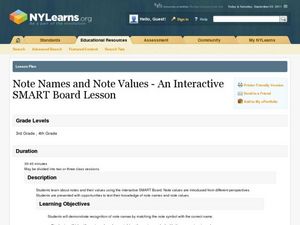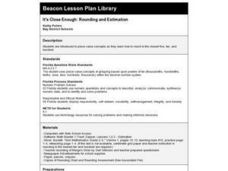Curated OER
Discovering pi
Tenth graders investigate the history of Pi and how it relates to circles. In this geometry lesson, 10th graders measure the circumference of a circle and the diameter of a circle. They relate these measurements to the number of Pi or 3.14
Curated OER
Mental Math: Breaking Apart to Add
Develop mental math addition skills by breaking apart addends into 10s and extras. Worksheet has problem solving steps at the top of the page, and 8 practice exercises that lead to increasing independence using the process.
Virginia Department of Education
Simplifying Square Roots of Whole Numbers
Simplify your life by using a resource on simplifying square roots. Pupils review square roots and calculate values of given radical expressions using a calculator. The lesson concludes by having them consider the results to develop the...
Curated OER
Put Your Hands on the Values-Math Manipulatives
Fifth graders visit Web sites on the World Wide Web for interactive practice in recognizing place value for numbers. They work in teams of two to practice identifying place values of whole number and decimals by creating place value cards.
Curated OER
Hula Hoop Hullabaloo
Second graders use hula hoops to represent the zero as they count objects into ones, tens, hundreds and thousands. They complete an activity to after they have practiced counting objects.
Curated OER
Rolling For Value
Young scholars participate in a lesson to comprehend the concept of probability while rolling dice. They recognize patterns while making observations and recording the data for each roll. Students also review place values while playing a...
Curated OER
Marking the Minutes
Students mark seconds, minutes, hours, days, etc. on class timetable report to keep track of time spent on Uninterrupted Silent Reading.
Curated OER
Decimals: Collaborative Lesson
Students explore mathematics by participating in a group activity. In this number value lesson plan, students identify the uses for decimals and how to best estimate whole numbers based on decimals and fractions. Students collaborate...
Curated OER
North Carolina Place Names
Fourth graders examine a map of North Carolina to discover the heritage left behind in the names of various places. They compare/contrast those derived from Native American culture to those derived from European settlers.
Curated OER
Where I Am From
Students study selected poetry to gain an understanding of influences on values and personal identity. They explore language terms such as personification, imagery metaphors and allusion. After reading a poem and discussing it,...
Curated OER
What is An American?
Students consider American values. In this individual responsibility activity, students discuss democratic ideals that the nation was founded on and participate in an activity that requires them to create "What is an American?" collages...
Curated OER
Efficiency Can Solve a Host of Problems
Students explore the concept of efficiency. In this efficiency lesson, students read an article about efficiency in various industries such as health care, retail, and auto repair. Students identify a company that they think could...
Curated OER
Perceptions - Frame of Reference
Students understand that a person's perception or judgement of something or someone is greatly influenced by one's frame of reference including one's values, beliefs, experience and country.
Curated OER
The Citizen in de Tocqueville's America
Students explore democratic values. In this government systems lesson, students listen to their instructor lecture on Democracy in America by de Tocqueville. Students respond to discussion questions connected to the lecture.
Curated OER
Classroom Guide for Coming to America
Learners discuss the pre-reading focus questions. In this reading lesson, students discuss and explore the book cover and title. Learners predict what they will learn from this book. Additionally, students read to find out what life is...
Curated OER
Money Math Carnival
Third graders explore money in a carnival format. In this money lesson, 3rd graders create a carnival of mathematics activities. Students determine the value of money in mixed amounts and explore how to create representations of money.
Curated OER
Using Patterns
In this math worksheet, students examine a drawing of a neighborhood made of geometric shapes. Students answer 5 questions about patterns they discover. Then students answer 5 word questions about address numbers by using logical...
Code.org
Sending Binary Messages
Pairs build a device that will be able to send a binary message. They then update their device to allow it to send four possible messages before upping the ante to eight. The provided self-assessment rubric comes with reflection...
Curated OER
Hey, Pythagoras! Help Me Understand Your Theorem!
Learners explore the Pythagorean Theorem. In this math lesson, pupils solve problems using the Pythagorean Theorem. They select the appropriate numbers to substitute in the formula to solve problems.
NASA
Food For Thought
Science can be quite tasty. A delectable unit from NASA shows learners why it's important to consider food, nutrition, and health in space. Four lessons explore the idea in great depth, including testing cookie recipes. Along the way,...
University of Wisconsin
Planting a School Rain Garden
Finally, the day has arrived for introducing plants into the rain garden. If you have been following the entire unit, this will serve as a helpful guide for planting day. If you have not been using the previous lessons in this unit with...
PBL Pathways
College Costs 2
What is the financial benefit for attending a community college for the first two years before transferring to a four-year college? The second part of the educational lesson asks young scholars to explore this question through data...
Curated OER
Note Names and Note Values-An Interactive SMART Board Lesson
Students discuss note names and symbols. In this music lesson, students identify note names and values. Students play a game using the SMART board in which they identify note names and values.
Curated OER
It's Close Enough: Rounding and Estimation
Second graders round to the closest five, ten, and hundred. They use place-value concepts of grouping based upon powers of ten (thousandths, hundredths, tenths, ones, tens, hundreds, thousands) within the decimal number system.








